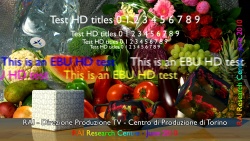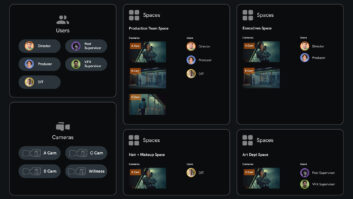
Are integrated production architectures mature for commodity use, and will 1080p50/60 HDTV become mainstream? David Wood and Hans Hoffmann, who lead the EBU’s technical department, look at likely short- and mid-term developments.
For a number of years two major trends have emerged in programme production. The first is the development of digital workflows that improve production efficiency and reduce costs through flexible, commodity IT-based production architectures.
Secondly, we have seen that today’s HDTV formats and mainstream HD production systems may not always be able to provide the technical quality required for premium HD productions. In addition, users have found that migration from IT-based production in SDTV towards HDTV has thrown up interoperability issues, particularly when HDTV production uses modern IT and file-based workflows involving different manufacturers’ products. Consequently the industry needs a solution to this interoperability dilemma and must come up with an optimum master production format for HD.
Two requirements for such an HD master are progressive scanning and high spatial and temporal resolution for multiple genre productions. And the 1920 pixel x 1080 lines 50-frame progressive image, as defined by SMPTE and ITU-R, had looked the most likely candidate.
However, recently this project has proven difficult to realise in cost-effective and mainstream products. In 2011, we may be witnessing a maturity of technology in both areas: interoperable and integrated production architectures that use the service-oriented architectures approach, and mainstream production equipment and software supporting 1080p/50.
The good news is that the European Broadcasting Union (EBU) and the Advanced Media Workflow Association (AMWA) have, since late 2009, established a joint taskforce on Interoperable Media Services, and in June 2011 the first Framework for Interoperable Media Services (FIMS) specification was published. This initiative has been backed by key manufacturers and will likely be a game changer for IT-based programme production. FIMS is a specific open interface and associated metadata that can be used to allow different systems to interoperate easily.
Current equipment can be made interoperable using the ‘media orchestration system’, with a FIMS adapter that converts the capturing or processing device interface to a common interface standard. New equipment can include the FIMS interface; the specification is now ready
Several manufacturers have announced the implementation of FIMS in their products end of 2011 — early 2012. An added advantage of FIMS is that it eases the monitoring and harmonising of the technical workflow with the business workflow. Building on the success of FIMS 1.0, the project is already planning the definition of new FIMS interfaces for more services. For information about FIMS and details of the specification, see http://wiki.amwa.tv/ebu.
Premium HD in 1080p50/60?
HDTV’s launch in Europe sparked debate about the ‘best’ HD format in production and delivery. But it has become apparent that there is no longer a need to keep the same image formats in production, distribution and presentation. In addition, while the experts were extolling the advantages of a fully progressive system like 1080p/50, the reality of legacy product availability has held the technology back.
Receiver chip makers contested that forced implementation of H.264 Level 4.2, as required for 1080p/50, would drive HDTV receiver costs too high. Today the situation has changed. DVB has included Level 4.2 in its specifications, and all consumer display compliant to DigitalEurope’s HDTV 1080p label can display 1080p/50-60 via the HDMI 1.3 interface. Newer set-top boxes have chips that can decode H.264 Level 4.2 (1080p/50-60), similar to two stereo-3DTV streams, each with 1080p/25 (or two 720p/50 or 1080i/25 streams).
Research done by the EBU in 2005 found that for the same degree of compression artefacts, the broadcast bit rate for 1080p50 would be similar to or less than the bit rate for 1080i/25 (though 15-20% higher than for 720p/50) since ‘interlacing’ is more strenuous for the encoder and decoder and causes typical artefacts. 1080p/50 compared to the same interlaced bit rate could provide a better image quality and would, in addition, offer business considerations for stereo-3DTV too.
There is still a major hurdle in broadcasting 1080p/50 in an environment of legacy 1080i/25-30 and 720p/50-60 receivers. But here too, business considerations, such as the premium quality argument, international exchange or best quality archives, and using next generation compression codecs, like HEVC, are been developed. This will further bring down the bit rate requirement for distribution.
It should also be noted that the hype around 3DTV in recent years has reached a more realistic tone – 3DTV has matured. This means that 3D event-based broadcasts can compatibly use the infrastructures put in place for new 1080p/50-60 2D HDTV capable receivers. This can be achieved by using two native resolution legacy HD formats (720p/50, 1080p/25, 1080i/25) each representing the left-right view, with new advanced and bit rate efficient (2D plus 3D delta) algorithms.
For programme production we are seeing a steady movement towards 1080p/50 capable products. Content creators are realising that the technical quality of programmes is a commercially competitive factor, and that 1080p/50 can bring advantages for certain genres in the home too, such as live sport, which excels through the improved motion portrayal of 1080p/50. Whereas in the past 1080p/50-60 was only available for very expensive cameras with inefficient dual link interfaces, it is now becoming a commodity option for all production systems in the chain via a single link interface.
In one of our recent strategic programmes, EBU Technical extensively tested new 1080p/50 capable studio codecs from Sony, Panasonic and Avid, and provided practical guidelines on new studio infrastructures based on the SMPTE 3G-SDI standards. In addition, an internal EBU Technical feasibility study was undertaken to set up a full realtime production test chain in 1080p/50, including contribution and distribution codecs. This flow will be demonstrated at IBC2011.
In the next two to three years many broadcasters will face the first reinvestment cycle for HDTV production systems, and the availability of 1080p/50-60 options in cameras, including 3G-SDI realtime infrastructures and non-realtime file-based production are a worthwhile consideration. This could enable future-proof investments, competitive advantages in high quality HDTV programme exchange and, ultimately, a superb image quality delivered to the viewer. And the support of stereo-3DTV in 1080p/50 infrastructures may prove to be a valuable argument.






